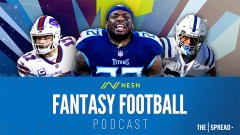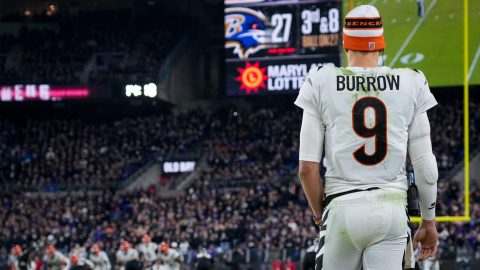Fantasy Football Rundown: Strategies, Structure To Know Before Drafting
Important tip: Strongly consider a player's average draft position
Fantasy football is a fun way to keep in touch with friends, family, and coworkers during the NFL season. It’s also a good way to stay up to date with the NFL from week to week. For those who have never played before, drafting or staying on top of your fantasy team can seem daunting.
Here’s a breakdown of what to expect and keep in mind.
DRAFT STRUCTURE
Every league will have different scoring rules, roster structures, and playoff formats. The typical league will consist of 12 teams, but leagues with eight and 10, and even 16 exist.
Each fantasy football league will have a different way of choosing draft order. Once you get your order, the most popular format of the actual draft is a snake draft: If you pick first in Round 1, you would then have the last pick in Round 2.
There also are salary cap drafts, which are like an auction. Players are put on the board one-by-one and members can bid a certain amount. Whoever offers the highest bid, gets to draft the player.
LEAGUE TYPES
Part of learning the basics is learning the different league types. It’s important knowing your league’s scoring system, as players who have more catching targets will be more valuable in fantasy football leagues where a catch is worth a point (known as a PPR league).
The following formats are the most common:
PPR: Individual players will get a full point for every reception
Half-PPR: Individual players will get half a point for every reception
Standard scoring: Individual players will get no points for a reception
IDP: Individual defensive player. Defensive players can get points for tackles, sacks and turnovers.
SuperFlex: You can start a QB in your flex position.
Best Ball: Best ball is interesting because you don’t need to be on top of your roster as much post-draft because you don’t need to manage your lineup. Your week to week starters are selected based on the highest scoring players.
Dynasty: If this is your first year, this wouldn’t apply to you but it’s good to know. A dynasty league means players you draft are carried over from season to season.
Keeper: A keeper league is similar to a dynasty in that you can keep players from one season to the next. The difference is, a dynasty league allows most or all players to remain on your team while a keeper league involves keeping a smaller amount of those players.

WHAT A ROSTER WILL (LIKELY) LOOK LIKE
A typical fantasy football team’s starting roster will include the following: quarterback, two running backs, two wide receivers, tight end, flex — choice of a RB, WR, or TE — kicker and defense. There will be another six or seven bench spots for all of the above, too.
DRAFTING PROCESS AND STRATEGIES
I won’t give you an order of what position to draft where because there are several different strategies to do so. Creating your own or researching one that you like best can be one of the most fun parts of the process. However, I will stress the importance of considering a player’s average draft position (ADP). The reason it is important to consider a player’s ADP is that it helps you anticipate which players will be available in later rounds and also can help you take advantage of a possible mistake made by others in your draft. For example, if the person drafting before you leaves a player on the board that can be found near the top of your ADP list, you can identify that player quickly and draft him.
A lot of strategies suggest a running back-heavy approach in the first few rounds, which is the case for a few reasons. In the fantasy world, running backs are coveted and fly off the board in the first round not only because the pool of reliable and elite ones is limited, but because they score touchdowns most often. With that said, there are some drafters who go with the “zero RB” strategy and draft two or three WRs in the first three rounds instead of a running back. It’s all about finding the approach that works for you.
Kickers and defense should come last. Even the best defenses and kickers in the league won’t give you a big edge because of the lack of points they bring to the table.
The number of rounds in your draft will depend on your league settings, but it will range from 14-16. I’ve included on potential strategy here:
ROUND 1: Draft a RB or elite WR (ex: Cooper Kupp, Justin Jefferson)
ROUND 2: Draft a RB or elite WR or elite TE (ex: Mark Andrews, Travis Kelce)
ROUND 3: Draft a WR or elite TE
ROUND 4: Draft a WR
ROUND 5: Draft a WR or RB
ROUND 6: Draft a WR, RB or elite QB (ex: Josh Allen, Patrick Mahomes)
ROUND 7: Draft a QB, TE, RB, or WR
ROUND 8: Draft a WR or RB
ROUND 9: Draft a QB, WR or RB
ROUND 10: Draft a RB or WR
ROUND 11: Draft a RB, WR, TE or QB
ROUND 12: Draft a player at a position where you don’t have as much depth
ROUND 13: Draft best player available (check out your depth and ADP)
ROUND 14: Draft a defense
ROUND 15: Draft a kicker
POST-DRAFT
This is where the fun begins. You have your roster and you are ready for Week 1. Let’s talk about some of the basics to keep in mind from here on out.
Starting/Benching: Once you have your roster, each week you should be looking at matchups and determining which players to start and which to bench. Keep in mind byes, injuries and game script. In most fantasy football leagues, there are 16 players on a team, which means you would have nine starting players and seven bench spots each week.
Trading: The roster you have post-draft does not have to be your season-long team. Each week, you can trade players within your league as well as drop and pick up new ones from the waiver wire. With trading, a certain time will be allotted to a trade request for the opponent to respond. There are different strategies that go along with trading — just remember to do your research and make sure the trade is fair and smart on your end.
Waiver Wire: The waiver wire is a weekly pool of undrafted players. Standard leagues will have an order for waivers each week, which will be determined by your individual group. The best thing to keep in mind with the waiver wire is to find a player who could possibly be getting more playing time one week or that is simply producing more or seems to have a higher ceiling than one of your current players.
I get that this breakdown itself is intimidating, but just keep in mind: this is supposed to be fun. You don’t need to know everything. Get involved in some mock drafts, make mistakes, and lean on your friends who are experienced. Don’t be afraid to take some risks and see what works for you.




